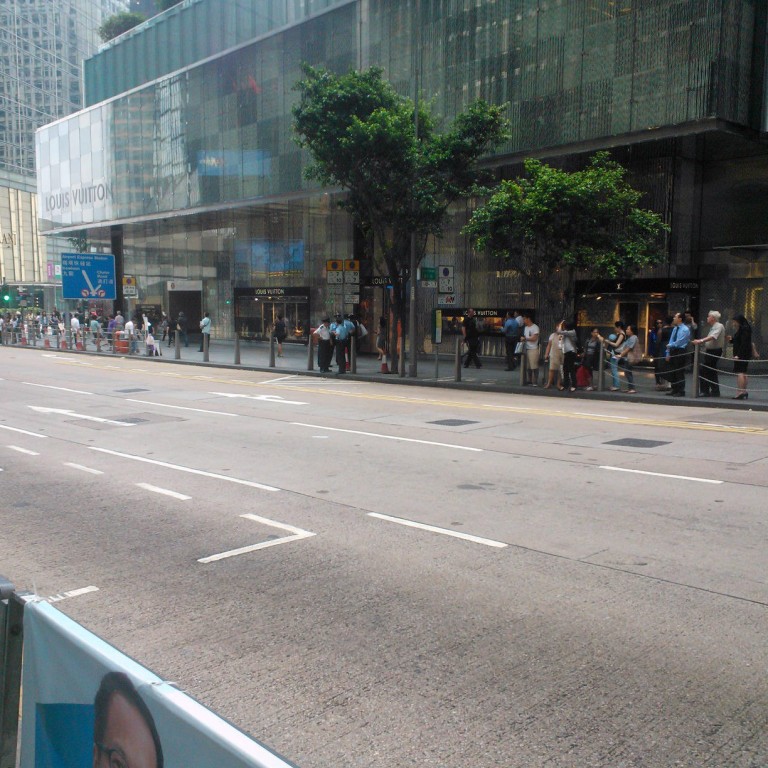
Bag-toting tai-tais wonder where the chauffeur's gone
We have been reprimanded for our piece yesterday about Hong Kong having the world's fifth-highest number of police per 100,000 population. A retired senior police officer has written in to say that it is not just the total number of police officers that need to be considered but also the productivity.
We have been reprimanded for our piece yesterday about Hong Kong having the world's fifth-highest number of police per 100,000 population. A retired senior police officer has written in to say that it is not just the total number of police officers that need to be considered but also the productivity. "HK has some interesting crime statistics, perhaps more relevant than the 'illegal car parking mess' you referred to." He goes on to say that, "our police officers are expected to concentrate their efforts on the prevention and detection of crime, and, for example, the murder rate in HK is one-fiftieth (2 per cent) of that in Washington DC". wonders whether that is because of the presence of "Asia's Finest" or more because the propensity for murder is much lower than in Washington.
He adds that "we get excellent value for money from our police force, and would be most interested in any facts which might indicate otherwise". On that note, we see from the photograph in this column, sent in by a reader, showing Pedder Street in a rare moment free of illegally parked vehicles and lingering Kowloon taxis. This, we are told, was due to a spate of what our reader described as "extreme policing diligence" by a posse of six policemen. He also observed the regular appearance of stunned, bag-toting tai-tais wondering where the chauffeur went. An interesting departure, but not one that is expected to endure.
Despite the pictures and reports of choking smog in the mainland's big cities, air pollution is not its main environmental problem. The worst problem is water, according to mainland environmentalists, because of its scarcity and the extent of its pollution.
Two grim pieces in recently pointed out that in the 1950s, China had 50,000 rivers, which has now fallen to 23,000, a loss of 27,000, largely as a result of over-exploitation by farms or factories. The country uses 600 billion cubic metres of water a year, which is about 400 cubic metres per person. This is a quarter of what the average American uses. Northern China, which has half of the population and most of the farmland, has just one fifth of the usable water supply. The definition of international water stress, according to the Global Water Forum, is 1,700 cubic metres of usable water per person per year. The average northern mainland Chinese person has less than 200 cubic metres per year, which is well below the 500 cubic metre threshold considered to be "absolute water scarcity". Beijing's water table has dropped 300 metres since the 1970s. Then there is the pollution. According to the land ministry, more than half the groundwater in the north China plain cannot be used for industry while 70 per cent is unfit for human contact, even washing.
Despite the shortage, the mainland is building cities in the desert, and is pushing ahead with plans to develop shale gas even though most of the reserves are in the driest part of the country. The World Bank says the cost of the mainland's water problems amounts to 2.3 per cent of GDP, mostly in the form of health problems. What can be done? One suggestion, says, is to reduce demand by raising the cost of water, which is too cheap at about one-tenth the price of Europe's. Not for nothing did former premier Wen Jiabao once say that water shortages "threaten the very survival of the Chinese nation".
Executives with BNP Paribas' London fixed income business have had to apologise to staff after a dinner, which was supposed to be a morale-boosting event, ended in embarrassment. The dinner, according to the website eFinancialCareers, took place last month in a London art gallery. It began well enough with a string quartet and free-flowing champagne. However, things seemed to go awry during dessert when a woman wearing a tutu appeared on stage. She soon whipped this off and, clad in a "scanty leotard", began to gyrate around a pole which had been put there for the purpose.
Detailed accounts from attendees indicate the dancer delivered a fairly raunchy pole dance. The act came as something of a surprise since the performance had been billed, according to the website, as a Swan Lake-style ballet with Cirque du Soleil overtones.

